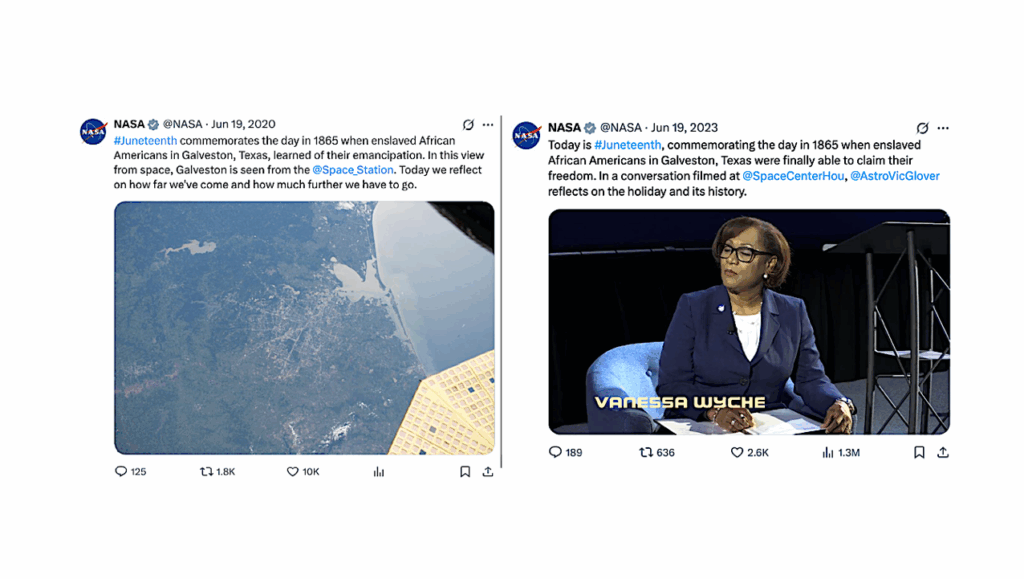All That Wacky Secret Stuff That NASA Supposedly Does

Aliens, bunny-killing rovers, and a Moon base: What all is NASA “hiding”?, Ars Technica
“Spend any time around NASA public affairs specialists, as I do, and you’ll eventually get the eye roll. It comes when someone inquires about aliens or faked moon landings or all manner of other nonsense. One of the more recent eye-rollers originated in Russia, where officials said sea plankton was growing on the exterior of the International Space Station. (It wasn’t.) “If you think that’s bad, you should Google ‘NASA hiding,'” one space agency official told me. So I didand here are the first five things I found.”
 Keith’s note: Of course NASA does not help itself with the conspiracy crowd when it funds quackery such as the warp drive project at JSC and the LENR project at LaRC – both of which defy conventional physics, have yet to yield any reproducible results, and for which NASA is not even willing to reveal budgets or objectives.
Keith’s note: Of course NASA does not help itself with the conspiracy crowd when it funds quackery such as the warp drive project at JSC and the LENR project at LaRC – both of which defy conventional physics, have yet to yield any reproducible results, and for which NASA is not even willing to reveal budgets or objectives.









Be careful Keith…. I’ve read your articles and postings for years now. For the most part I agree with much of what you have to say. That said, “defy conventional physics” leads to closed door ideas. Sailing around the world without falling off the edge too ‘defy conventional physics’ for the knowledge available for the day. Just because we can break orbit and land on the moon, we should not be so pompous as to say ‘defy conventional physics’ in a field that is constantly evolving.
I am not going to “be careful”. The warp drive and LENR projects are a colossal waste of taxpayer’s money and have produced zero science. NASAHeadquarters is embarrassed by both of these projects but cannot do much of anything due to internal management problems and external politics.
Waste of taxpayer money, yes. “Colossal” waste? I don’t know. How much money is spent on those projects? From what I’ve seen, their budgets are like a rounding error in the budgets of projects like the James Webb Space Telescope.
Both projects are complete nonsense and cost hundreds of thousands of dollars. How many college educations is this equal to? How many cubesat launches? When people start to talk about sums of money like this as rounding errors they become part of the problem.
Although I might never say never; in the lifetimes of NOBODY reading this will ‘warp drive’, ‘light barriers’ or ‘anti-gravity’ etc be solved. It would be far better to concentrate on technical problems that could benefit space travel and exploration for the next 20 years, not the next millennium. If people want to pursue the fools gold of warp drive; let them do it with private money and private think tanks.
I’d disagree, with the exception of the timeframe.
Consider that while we have some understanding of baryonic matter, in the main the universe remains entirely opaque to any explanation yet fashioned; and even ordinary baryonic matter is fond of tossing out new particles stressing the already tired SUSY.
In truth we are so laughably primitive that we don’t even know where to look in the search for a deeper comprehension of the universe. I’d say that dismissing radical research by comparing to acquired knowledge is short-sighted.
I would have to disagree. Knowledge of the universe is certainly incomplete but QCD, the Standard Model of particle physics and General Relativeity have made numerous predictions which have been tested to great precision.
True. But the Universe outside baryonic matter–5% or so of the mass we think extant– remains entirely opaque. Nobody has a clue about dark matter, for instance, though I am happy to see Lisa Randall (and others) turning at least some attention to the issue. On-going experiments are important but remain a shot in the dark, so to speak.
The Standard Model has been robust but again limited to light-sensitive matter. Super symmetry is in some danger from new particles being generated at CERN.
We have some knowledge of a very, very small part of the universe. This is why I scoff at claims that FTL or other feats of seeming-magic in the dim future will never become reality. We are so primitive it’s impossible to say. The future–probably the far future–will hold wonders we can hardly imagine from our view on the back of a horse.
And I would also point out that there have been no major leaps in understanding from the world of physics for many many decades. We are in at least some sense stymied and without real direction.
Knowledge evolves gradually, through increasingly accurate theoretical approximations to the truth. Newton built on Galileo and Einstein on Newton. Although the exact nature of dark matter remains unclear, the observations of anamolous stellar motion that implied its existence were first made decades ago. Some types of potential interactions have been hypothesized and essentially eliminated by lack of detection, observations of galactic collisions in which the ordinary and dark matter are separated and gravitational lensing by dark matter have Even if DM interacts _only_ by gravity its nature is becoming better defined.
Good points. Perhaps my impatience is showing?
I’ve wondered if the weak nature of gravity and the elusive qualities of DM have some sort of fundamental relationship. At the very least both observations make the point that our knowledge of the Universe is paltry at best.
What do I know? I’m a classics major.
I wouldn’t call it rounding error. But that amount of money also isn’t all that large. To answer your questions, funding for a graduate student is about $50,000 for six years. CubeSats doing real science are something like $1 million per unit, although ones which are more of a teaching/training project for students can be a factor of a few less. $100,000 per year is also the typical size for a NASA research grant. Having been on review panels for those, the projects you are complaining about would not get rated as “findable.”
While I can not say if the warp drive or LENR projects are a “colossal waste” or not (I do not pretend to know enough to judge and to be honest there are a few too many who believe that they know everything there is to know about physics and are therefore supremely qualified to be judge, jury and executioner of these projects) I do feel that such projects should not be simply denied funding just because they are unorthodox, go against current known physics and causes a lot of tutting about “Bad science” in “scientific” circles. If we really want to look for “Colossal wastes of money” we really should look at projects that will almost certainly be rendered obsolete by the time they eventually come to fruition not projects that are simply perceived by “pious scientists” as being “unworthy”
Uh, we know that educated people didn’t believe the world was flat going back at least to the ancient Greeks, a few hundred years BC. Long before Europeans were capable of sailing beyond the Med, they knew the Earth was round. (They even had a surprisingly accurate estimate of its size going back to Eratosthenes around 200BC.)
[Edit: I forget to point out, it’s also a classic fallacy. Just because people “laughed at the Wright Brothers”, doesn’t mean that everyone who is laughed at is like the Wright Brothers. Science without skepticism is just a bunch of people making crap up.]
I still can’t believe they’re funding Sonny White. He must have some friends in high places at NASA.
Be careful about bashing LENR, as no less than Airbus Woodford fund, Cherokee fund, Japan NEDO program, Baishishan technology Park, Navy NRL, are involved.
Role of nasa is not to improve gasoline engine but to develop technology at the edge of what is possible, which imply going beyond what is assumed possible and checking.
If you desire US miss again the next revolution like it did with Wright brothers or Sputnik, continue that way… I’m european, and we are even more stupid… except that Airbus seems to not have missed the LENR train.
The Asian, work on LENR on EmDrive, and they don’t need us to be intelligent.
by the way LENR does not break all what is known on physics, it is just an open territory in material science… not in particle or plasma physics (which explains why physicist are out on that subject… and why ST Micro was in ).
Ed Storms is proposing something that integrate experimental results, probably to be improved
http://lenr-canr.org/acroba…
for Nasa pedigree in LENR you can read
http://www.grc.nasa.gov/WWW…
http://newenergytimes.com/v…
http://ntrs.nasa.gov/archiv… (with Boeing)
http://ntrs.nasa.gov/search…
You should also see Navy NRL and navy Spawar pedigree, as Italian ENEA, Swedish Elforsk, French CEA (Longchampt), Japan (Toyota, MHI).
I am not going to “be careful” when it comes to outing quack science.
Keith, I think I like Matthew Black ‘s post the most. If I understand your view correct, you are right that at the current funding levels, NASA needs to focus on what it can do now and in the next generation. That said these are ideas that must be pursued to plausibility or failure. We fail to push the boundaries and better ourselves if we don’t try. To fail is simply another way to learn to succeed. We need to be wise enough to know when the tech is not available for the current year/decade/century, or if the cost of pursuing the advance in science offsets current domestic and international needs. However, I leave myself questioning if DARPA had been pursuing these ideas ‘openly’ or ‘secretly’ instead of NASA, would I still have an issue with the federal dollars being spent on currently failing or problematic future technology? The best stuff really does come from DARPA.
I agree Frank, thank you. For Space exploration – particularly manned – cryogenic and near-cryogenic propellant depots, Solar & nuclear-electric propulsion, lightweight radiation shielding, reliable long-term closed-loop life support systems and reusability of launchers, habitats and landers are the game changers for the current and probably next generation of Space Explorers. Most anything else is ‘fluff’.
You are clearly mistaken as everything you listed above is ‘directionless honeypots of open ended research’. The technology must be in the baseline program, or its simply left to flounder with a lack or resources. One has to be willing to have failures and take risks to move technology, err the ‘fluff’, forward. It is self evident that the, lol, ‘best stuff’ comes from DARPA: NASA simply builds an operates 40 year old technology and makes it more throwaway. The good news is that cold fusion is not being worked, and the few hundred K is actually challenging the community to examine or debunk concepts, unlike the billions spent redoing the same ole stuff.
There’s one small problem: they refuse to publish in peer reviewed journals. They are scared to do so.
I am not so confident in peer review. It’s just the opinion of an editor and two other authors who may have their own opinions. Publication in the open access press can be just as helpful in evaluating a new concept if the article is coherent and provides complete information on a hypothesis and experiment.
The concealment of data as proprietary or ITAR restricted is just as bad. In an area of considerable uncertainty failure to share information virtually guarantees failure.
I agree that peer review has its problems. But the advantage is that a non-specialist can be confident that a couple of specialist (or just one in, I believe, in the case of ApJ) have read over the paper and caught any obvious flaws in the methodology or interpretation. Of course, those are a couple of potentially biased specialists (or, in my opinion, definitely biases, in some direction and to some degree.) I think that’s your point.
Open access is fine, but it reverses the problem. It removes the bias but also removes a non-specialist’s confidence that someone would/should have caught any subtle problems with the work.
I’m reminded of Churchill’s comment about democracy. Something to the effect that it is the worst possible system, with the exception of every other system anyone has ever tried.
But as far as cold fusion and non-inertial propulsion systems, I don’t think these people are really trying. There are journals which are all about measurement techniques and methodology. Research in Scientific Instruments comes to mind. How about a few minor papers, not on the impressive results they claim (which a biased reviewer might stomp on) but about their impressive efforts to rule out experimental error as a source of their unexpected results. They wouldn’t even have to mention what they think the real explanation is, and they would get a lot more credibility by having a peer reviewed description of what they are doing.
Perhaps several companies developed and tested concept, and one or none ‘worked’, and three different independent tests were conducted with similar results. The companies however, do not want to disclose their results nor process, good or bad. Now suppose the USG was able to replicate the results of each concept based on interaction with the companies. Regardless, if USG funded it may take several years or more before disclosure depending on the data rights. If they cite ITAR or if concept was developed using private funds, etc, perhaps never, even if the USG funded the bulk of the work.
I don’t agree – and you either don’t fully understand my context or you are simply wrong: Everything I listed are things that would enable manned space exploration (Moon, Mars or both) to eventually be done in a technically superior way to near-traditional brute force engineering or Apollo-like throwaway methods. Developing the listed technologies will virtually bootstrap a better future and ways of doing things in space.
But without clear leadership, funding and stated goals and destinations, then I agree that pursuing enabling technologies without any end goal(s) in sight might result in ‘honeypots’ and endless pork spending for it’s own sake. A bit like a boxer who trains endlessly but never fights anyone.
Or choose any other similar analogy or metaphor you like…
It is in the nature of fundamental research to appear, to some at least, as nonsense, particular non-specialists; and it is also in the nature of fundamental research to locate blind alleys far more frequently than fruitful avenues.
I’d say that both of these projects probably need a few more years, after which a giant hand comes down and finds the plug.
An experienced physicist provides a concise assessment of the Windom-Larsen theory of low energy nuclear reactions (LENR)
http://physics.stackexchang…
The Windom-Larsen theory of low energy nuclear reactions (LENR) proposes at least four novel phenomena: plasmon formation by RF excitation, neutron formation by proton-plasmon capture, neutron absorption by interaction with energized electrons, and the interaction of neutrons generated in a nucleus with the surrounding condensed matter. All these phenomena must first be theoretically analysed and then tested in isolation to have any chance of resolving the uncertainties of a combined experiment. Any observational experiment in particle physics is likely to have error sources that are greater than the measured parameters. These error sources must be carefully accounted for before any conclusions can be drawn about the actual hypothesis. Look at the Higgs and dark matter research if you think verifying a new theory is easy,
Two organizational obstacles to all LENR/CF research:
1. DOE must be involved. This would provide access to capable researchers with extensive experience in nuclear and particle physics and critical facilities which NASA lacks.
2. Almost every LENR effort is led by a company that keeps critical data proprietary, making it more difficult to tell what they are claiming. Data has to be shared to have a chance at real progress.
A review of the status of the theory:
http://newenergytimes.com/v…